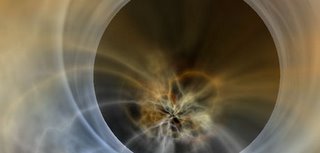 Andrew J Hamilton, a professor of astrophysics at the University of Colorado, has merged video game techniques with video game technology, to create visualizations of black holes and other astral bodies/phenomena. He calls it his black hole flight simulator. This is part of a new show at the Denver museum of Nature and Science.
Andrew J Hamilton, a professor of astrophysics at the University of Colorado, has merged video game techniques with video game technology, to create visualizations of black holes and other astral bodies/phenomena. He calls it his black hole flight simulator. This is part of a new show at the Denver museum of Nature and Science.In an interview, he mentions...
"What if you could take people through a wormhole the way Einstein's equations said it would be? And what if you could bring art and science together in a way that compromised neither?"Some interesting excerpts...
The show is built on the crunching of numbers that even a black hole might envy: some segments produced by the National Center for Supercomputing Applications at the University of Illinois required 90 hours of supercomputer calculation for each second on screen.
...
The simulator, to be featured this year in a "Nova" program on PBS about black holes, seeks to lift the veil. Using Einstein's equations and a graphics language called Open GL, developed by Silicon Graphics, Dr. Hamilton told the computer to show how individual vectors of light should behave at the no-man's frontier of the black hole, called the event horizon, and inside the hole itself.
...That meant not only creating a visual representation of Einstein's work, but also in a real sense creating from scratch a world that cannot be known. "When I started this, I had no idea what would emerge from the equations," Mr. Hamilton said. Part of the thrill was the exploration. The computer would go where the human mind by itself could not.
Original link via the New York Times.
Watch a trailer to the show.
Cross-posted on Ek Cup Coffee.
No comments:
Post a Comment